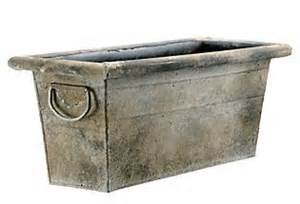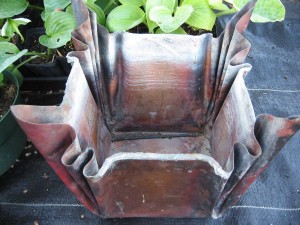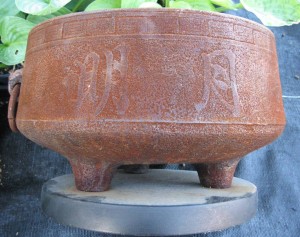Copper is one of the necessary plant nutrients, but it is toxic beyond small amounts. Overuse of copper dormant spray can actually cause damage to plant buds and (in my case) created an allergy reaction to the applicator. When I stopped spraying dormant sprays my supposed 12 year allergy to ‘ALDER’ disappeared.
Nursery growers of large ornamental trees often spray the wooden inside of these containers with copper. In so doing the fine root hairs that touch the copper infused sides die, forcing the plant to put finer root growth towards the inside. Copper lined containers, copper treated burlap, copper treated root barriers, copper lined grow bags are all used in the nursery industry. Customers do NOT want to see roots growing through that burlap. Go figure.
One trick some use is to spray the inside surface of the copper container with a couple coats of automotive undercoating. It seals the surface to prevent leaching and corrosion. Plant away! So lined one has another benefit: copper repels slugs and snails so such containers would be ideal for Hostas or other plants that send an invite out to these pests. Orchid growers would regularly coat their growing benches with copper or put bands around the 4 by 4’s with this purpose in mind.
At present, I am going to put an ornamental driftwood piece into my garden. As it is a tall vertical piece I will have to make a holding base for it. Aside from even more toxic wood preservatives, copper was often used. Plants such as grape vines near those treated supports did not thrive as well as others not near the wooden supports.
Other questions remain on feeding: (and I will skip the hamburger issue, since I do not eat it myself) Insects are far less fattening.
Most sites say NO to fertilizer. I beg to differ, but do stay with organics and or VERY diluted acid plant foods. I would add that the chlorine or fluoride in household water would be of greater concern. Even well water PH changes during the seasons, becoming more alkaline in my case as the aquifer changes come November.
Use this much-diluted mix every 6 to 8 weeks from spring to autumn. One can either top water or apply to the tray beneath the pot. I see little difference as neither draw oxygen into the soil. I prefer to totally submerge the pot in water in a 4- 6 week frame. Empty the standing stagnant water in the tray and let the pot DRAIN totally. In so doing the draining water can draw oxygen into the soil. Return the drained pot to the tray and fill it with fresh water. Please note that wider shallow pots can drain more poorly than regular ones. Adding some extra drainage material to the bottom might be beneficial. More important would be to use an orchid or begonia pot that has drainage holes on the bottom AND on the sides.
If you are nervous about this, test this out on some plants and see the reaction. One thing I use is a tea I make from Dr. Earth, left to stew for 24 hours, diluted and then applied.
This applies only to Venus flytraps and Pitcher plants. I would Not fertilize Pinguicula (Butterworts) Bladdeworts and I would be very cautious about Sundews. This would even apply to Bromeliads, although Orchids I raise do get their diluted fertilizer.
My other sites begin with the discussion of my garage sale entitled ‘Sarracenia and the tale of two pots.’ Basically it is an overview of certain species and hybrids I would try to match to these pots. That CHEAP pot became very costly indeed. At the moment I am losing another bid for a ‘copper’ colored Sarracenia.
My first incursion resulted in ‘Sarracenia plants! They work for their upkeep!’ I so love houseplants that provide for organic pest control. What I did not mention was that most are in my small greenhouses which are home to Heurnia and Stapelia. The rotting smell of their flowers make S. ‘Fat Chance’ happy indeed.
Lastly, I recommend “The Savage Garden” by Peter D’Amato – a most enjoyable read.





